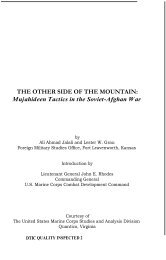hindustani fanatics, india's pashtuns, and deobandism â connections
hindustani fanatics, india's pashtuns, and deobandism â connections
hindustani fanatics, india's pashtuns, and deobandism â connections
- No tags were found...
You also want an ePaper? Increase the reach of your titles
YUMPU automatically turns print PDFs into web optimized ePapers that Google loves.
Hindustani Fanatics, India’s Pashtuns, <strong>and</strong> Deob<strong>and</strong>ism – Connectionsrecovery of his former possessions <strong>and</strong> reinstatement at Panjtar. Mubarak Khan, who after his expulsion from the Totalai village, <strong>and</strong> the destructionof Panjtar <strong>and</strong> Mangal Thana by our troops, had come in to the commissioner of Peshawar, <strong>and</strong> been allowed to reside in British territory, was theprime mover in this plot, by which he sought to regain his former position. His money cemented the various alliances, <strong>and</strong> purchased the neutralityof some of the Buner chiefs; <strong>and</strong> on the 2 nd of August Zaidulla Khan (Bunerwal) committed the first overt act of hostility by seizing a number of Swattraders passing through his l<strong>and</strong>s. The Akhund immediately mustered his followers <strong>and</strong> directed the Buner tribes to break up the league by expellingthe Hindustanis <strong>and</strong> putting to death the refractory chiefs. In pursuance of these orders, the Isazai <strong>and</strong> Salarzai Bunerwals attacked <strong>and</strong> killed ZaidullaKhan in his house. On the 12 th they arrived, together with the Akhund’s followers, before Bazkata, <strong>and</strong> sent a message to the chief Maulvi, giving himone day to remove all his followers, women <strong>and</strong> children. The <strong>fanatics</strong> at first thought or resistance, <strong>and</strong> exchanged a few shots with the Salarzais,but were induced by Azim Khan to give in <strong>and</strong> commence preparations for a retreat. The next day the whole body evacuated Bazkata, the women <strong>and</strong>children being sent on ahead, <strong>and</strong> the rear brought up by a guard of 50 or 60 men armed with rifles. For the first few miles all went well, the Bunermen occupied in plundering <strong>and</strong> burning the deserted settlement; but as the fugitives neared the pass between Bazkata <strong>and</strong> Batora, they saw the hillson both sides held by the Akhund’s followers. The mass of fugitives, including the Maulvi Abdulla, Azin Khan, <strong>and</strong> the Buner chiefs, pushed onthrough the pass <strong>and</strong> made their escape with only slight loss; but the rear-guard was cut off, <strong>and</strong>, after a gallant st<strong>and</strong>, entirely destroyed. From Batorathe fugitives fled to Galima Bori in Chagharzai. Here they obtained a short respite, <strong>and</strong> even conceived hopes of being able to establish themselvespermanently, being promised support in the event of attack by the Amazais <strong>and</strong> Guni Khel section of the Chagharzais.The power of the Akhund, increased by his complete triumph over the rival faction in Buner, was however too great for them. The Chagharzaisobeyed his order to expel the <strong>fanatics</strong>, who continued their flight through Tangora to Bihar, on the banks of the Indus, where they arrived about the 18 thof September 1868 with 20 or 30 wounded men. Later accounts of them are very conflicting, but it is certain that the chief maulvi, with some hundredsof followers, came over to Jodhbai, <strong>and</strong> that many of them remained there till the British force arrived on the crest of the Black Mountain. The <strong>fanatics</strong>were welcomed <strong>and</strong> assisted by the Pirzada, son of the late Haji of Kunhar, by the son of Baj Khan of Kabilgram, Akhund Khel, <strong>and</strong> by the Kahil Mian<strong>and</strong> the Saiads of Bihar. Through their instrumentality they obtained the grant of a hamlet in Jodhbai, <strong>and</strong> were enabled to purchase several rafts,thus getting comm<strong>and</strong> of the river, <strong>and</strong> making themselves independent of the extortionate Pashtun ferrymen. Whilst at Jodhbai, the Maulvi receivedletters (it is said) from Ghafur Khan of Tikri, who offered to give the whole body of fugitives an asylum in his fort <strong>and</strong> l<strong>and</strong> in the Tikri valley; <strong>and</strong>from the Alahi jirga <strong>and</strong> chief of Tahkot, who promised to accompany the Pirzada to Jodhbai to hold a big council, <strong>and</strong> discuss measures of resistanceagainst the British. Mubarak Shah was summoned by him, <strong>and</strong> the war party cis-Indus was daily increasing. It seems probable that a month later theforce under General Wilde would have found a powerful coalition <strong>and</strong> some organized plan of defence; but its rapid approach disconcerting them,the <strong>fanatics</strong> hastily re-crossed the river, deserting their Chagharzai hosts, <strong>and</strong> thereby departing from their profession as soldiers of the faith, <strong>and</strong>destroying the last remnant of their former prestige, already injured by the treatment they had met with at the h<strong>and</strong> of the Akhund <strong>and</strong> his disciples.The main body went to Palozai, a village of the trans-Indus Hasanzais, who, however, refused to allow them a permanent settlement. From Palozaithey went to Tahkot, but finding no resting place there, they moved down the river to Bihar <strong>and</strong> Jodhbai of the Chagharzais; but ultimately beingobliged toab<strong>and</strong>on this refuge also, they at last threw themselves on the mercy of the Hasanzais. Here they received some l<strong>and</strong> called Maidan, whichwas granted them chiefly through the influence of the two leading men of Palozai, Malik Habib, <strong>and</strong> the Pirzada of the Hasanzais. The settlementnow comprises a mud fort surrounded by huts, all erected by the Hindustanis themselves (vide Kala Mujhi-i-Din). They are said now to muster 400efficient fighting men; <strong>and</strong> though not so well equipped <strong>and</strong> armed as they were at Ambela, they are still better armed than the neighbouring tribesmen,which fact, combined with their superior intelligence, gives them a certain amount of influence. They possess percussion muskets with bayonets, <strong>and</strong>Tribal Analysis Center, 6610-M Mooretown Road, Box 159. Williamsburg, VA, 23188
















